I know I'm very late to this party, but I wrote up a more elaborate function to generate a set of contrasting random colors for another project. They are both (at least somewhat) attractive and genuinely random (not based on predefined colors) but my code is a bit more complicated than some of the other responses (so it's not for just getting the basics)
This is for users who want to have more than one random color on their page, and want to make sure no two colors are too similar.
Fiddle
var generateRandomColors=function(number){
/*
This generates colors using the following algorithm:
Each time you create a color:
Create a random, but attractive, color{
Red, Green, and Blue are set to random luminosity.
One random value is reduced significantly to prevent grayscale.
Another is increased by a random amount up to 100%.
They are mapped to a random total luminosity in a medium-high range (bright but not white).
}
Check for similarity to other colors{
Check if the colors are very close together in value.
Check if the colors are of similar hue and saturation.
Check if the colors are of similar luminosity.
If the random color is too similar to another,
and there is still a good opportunity to change it:
Change the hue of the random color and try again.
}
Output array of all colors generated
*/
//if we've passed preloaded colors and they're in hex format
if(typeof(arguments[1])!='undefined'&&arguments[1].constructor==Array&&arguments[1][0]&&arguments[1][0].constructor!=Array){
for(var i=0;i<arguments[1].length;i++){ //for all the passed colors
var vals = /^#?([0-9a-f]{2})([0-9a-f]{2})([0-9a-f]{2})$/i.exec(arguments[1][i]); //get RGB values
arguments[1][i]=[parseInt(vals[1], 16),parseInt(vals[2], 16),parseInt(vals[3], 16)]; //and convert them to base 10
}
}
var loadedColors=typeof(arguments[1])=='undefined'?[]:arguments[1],//predefine colors in the set
number=number+loadedColors.length,//reset number to include the colors already passed
lastLoadedReduction=Math.floor(Math.random()*3),//set a random value to be the first to decrease
rgbToHSL=function(rgb){//converts [r,g,b] into [h,s,l]
var r=rgb[0],g=rgb[1],b=rgb[2],cMax=Math.max(r,g,b),cMin=Math.min(r,g,b),delta=cMax-cMin,l=(cMax+cMin)/2,h=0,s=0;if(delta==0)h=0;else if(cMax==r)h=60*((g-b)/delta%6);else if(cMax==g)h=60*((b-r)/delta+2);else h=60*((r-g)/delta+4);if(delta==0)s=0;else s=delta/(1-Math.abs(2*l-1));return[h,s,l]
},hslToRGB=function(hsl){//converts [h,s,l] into [r,g,b]
var h=hsl[0],s=hsl[1],l=hsl[2],c=(1-Math.abs(2*l-1))*s,x=c*(1-Math.abs(h/60%2-1)),m=l-c/2,r,g,b;if(h<60){r=c;g=x;b=0}else if(h<120){r=x;g=c;b=0}else if(h<180){r=0;g=c;b=x}else if(h<240){r=0;g=x;b=c}else if(h<300){r=x;g=0;b=c}else{r=c;g=0;b=x}return[r,g,b]
},shiftHue=function(rgb,degree){//shifts [r,g,b] by a number of degrees
var hsl=rgbToHSL(rgb); //convert to hue/saturation/luminosity to modify hue
hsl[0]+=degree; //increment the hue
if(hsl[0]>360){ //if it's too high
hsl[0]-=360 //decrease it mod 360
}else if(hsl[0]<0){ //if it's too low
hsl[0]+=360 //increase it mod 360
}
return hslToRGB(hsl); //convert back to rgb
},differenceRecursions={//stores recursion data, so if all else fails we can use one of the hues already generated
differences:[],//used to calculate the most distant hue
values:[]//used to store the actual colors
},fixDifference=function(color){//recursively asserts that the current color is distinctive
if(differenceRecursions.values.length>23){//first, check if this is the 25th recursion or higher. (can we try any more unique hues?)
//if so, get the biggest value in differences that we have and its corresponding value
var ret=differenceRecursions.values[differenceRecursions.differences.indexOf(Math.max.apply(null,differenceRecursions.differences))];
differenceRecursions={differences:[],values:[]}; //then reset the recursions array, because we're done now
return ret; //and then return up the recursion chain
} //okay, so we still have some hues to try.
var differences=[]; //an array of the "difference" numbers we're going to generate.
for(var i=0;i<loadedColors.length;i++){ //for all the colors we've generated so far
var difference=loadedColors[i].map(function(value,index){ //for each value (red,green,blue)
return Math.abs(value-color[index]) //replace it with the difference in that value between the two colors
}),sumFunction=function(sum,value){ //function for adding up arrays
return sum+value
},sumDifference=difference.reduce(sumFunction), //add up the difference array
loadedColorLuminosity=loadedColors[i].reduce(sumFunction), //get the total luminosity of the already generated color
currentColorLuminosity=color.reduce(sumFunction), //get the total luminosity of the current color
lumDifference=Math.abs(loadedColorLuminosity-currentColorLuminosity), //get the difference in luminosity between the two
//how close are these two colors to being the same luminosity and saturation?
differenceRange=Math.max.apply(null,difference)-Math.min.apply(null,difference),
luminosityFactor=50, //how much difference in luminosity the human eye should be able to detect easily
rangeFactor=75; //how much difference in luminosity and saturation the human eye should be able to dect easily
if(luminosityFactor/(lumDifference+1)*rangeFactor/(differenceRange+1)>1){ //if there's a problem with range or luminosity
//set the biggest difference for these colors to be whatever is most significant
differences.push(Math.min(differenceRange+lumDifference,sumDifference));
}
differences.push(sumDifference); //otherwise output the raw difference in RGB values
}
var breakdownAt=64, //if you're generating this many colors or more, don't try so hard to make unique hues, because you might fail.
breakdownFactor=25, //how much should additional colors decrease the acceptable difference
shiftByDegrees=15, //how many degrees of hue should we iterate through if this fails
acceptableDifference=250, //how much difference is unacceptable between colors
breakVal=loadedColors.length/number*(number-breakdownAt), //break down progressively (if it's the second color, you can still make it a unique hue)
totalDifference=Math.min.apply(null,differences); //get the color closest to the current color
if(totalDifference>acceptableDifference-(breakVal<0?0:breakVal)*breakdownFactor){ //if the current color is acceptable
differenceRecursions={differences:[],values:[]} //reset the recursions object, because we're done
return color; //and return that color
} //otherwise the current color is too much like another
//start by adding this recursion's data into the recursions object
differenceRecursions.differences.push(totalDifference);
differenceRecursions.values.push(color);
color=shiftHue(color,shiftByDegrees); //then increment the color's hue
return fixDifference(color); //and try again
},color=function(){ //generate a random color
var scale=function(x){ //maps [0,1] to [300,510]
return x*210+300 //(no brighter than #ff0 or #0ff or #f0f, but still pretty bright)
},randVal=function(){ //random value between 300 and 510
return Math.floor(scale(Math.random()))
},luminosity=randVal(), //random luminosity
red=randVal(), //random color values
green=randVal(), //these could be any random integer but we'll use the same function as for luminosity
blue=randVal(),
rescale, //we'll define this later
thisColor=[red,green,blue], //an array of the random values
/*
#ff0 and #9e0 are not the same colors, but they are on the same range of the spectrum, namely without blue.
Try to choose colors such that consecutive colors are on different ranges of the spectrum.
This shouldn't always happen, but it should happen more often then not.
Using a factor of 2.3, we'll only get the same range of spectrum 15% of the time.
*/
valueToReduce=Math.floor(lastLoadedReduction+1+Math.random()*2.3)%3, //which value to reduce
/*
Because 300 and 510 are fairly close in reference to zero,
increase one of the remaining values by some arbitrary percent betweeen 0% and 100%,
so that our remaining two values can be somewhat different.
*/
valueToIncrease=Math.floor(valueToIncrease+1+Math.random()*2)%3, //which value to increase (not the one we reduced)
increaseBy=Math.random()+1; //how much to increase it by
lastLoadedReduction=valueToReduce; //next time we make a color, try not to reduce the same one
thisColor[valueToReduce]=Math.floor(thisColor[valueToReduce]/16); //reduce one of the values
thisColor[valueToIncrease]=Math.ceil(thisColor[valueToIncrease]*increaseBy) //increase one of the values
rescale=function(x){ //now, rescale the random numbers so that our output color has the luminosity we want
return x*luminosity/thisColor.reduce(function(a,b){return a+b}) //sum red, green, and blue to get the total luminosity
};
thisColor=fixDifference(thisColor.map(function(a){return rescale(a)})); //fix the hue so that our color is recognizable
if(Math.max.apply(null,thisColor)>255){ //if any values are too large
rescale=function(x){ //rescale the numbers to legitimate hex values
return x*255/Math.max.apply(null,thisColor)
}
thisColor=thisColor.map(function(a){return rescale(a)});
}
return thisColor;
};
for(var i=loadedColors.length;i<number;i++){ //Start with our predefined colors or 0, and generate the correct number of colors.
loadedColors.push(color().map(function(value){ //for each new color
return Math.round(value) //round RGB values to integers
}));
}
//then, after you've made all your colors, convert them to hex codes and return them.
return loadedColors.map(function(color){
var hx=function(c){ //for each value
var h=c.toString(16);//then convert it to a hex code
return h.length<2?'0'+h:h//and assert that it's two digits
}
return "#"+hx(color[0])+hx(color[1])+hx(color[2]); //then return the hex code
});
}
Please note, although I don't do so in my example, that this can also be used to add new distinct, random colors to a set:
generateRandomColors(1,generateRandomColors(10))


